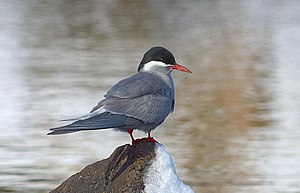Kerguelean Tern
| Kerguelean Tern | ||||||||||
|---|---|---|---|---|---|---|---|---|---|---|

Kerguelean Tern ( Sterna virgata ) |
||||||||||
| Systematics | ||||||||||
|
||||||||||
| Scientific name | ||||||||||
| Sterna virgata | ||||||||||
| Cabanis , 1875 |
The Kerguelean tern ( Sterna virgata ) is a species of the tern family . It occurs exclusively on sub-Antarctic islands in the Indian Ocean . It is a medium-sized, predominantly gray tern with a dark head cap.
The IUCN classifies the Kerguelense Tern as a kind of the warning list ( near threatened ), because the world population is very small overall. The population is estimated at only 3,500 to 6,500 sexually mature individuals, but is considered stable overall.
Appearance
The Kerguelense Tern reaches a body length of up to 33 centimeters. The wing length is 24.7 to 27 centimeters and the wingspan is 68 to 72 centimeters. So far, there is insufficient biometric data to show that there are gender-specific differences in size.
The Kerguelen Tern is very dark in color compared to other terns. The tail is not forked very deeply and the tail feathers are shorter than is the case with other species of the genus Sterna . The legs are very short. The beak is also relatively short and narrow and bright red. The legs and feet are also bright red. Kerguelen swallows in their splendid dress have a black head cap that extends only slightly to the back of the neck. A striking, broad white line separates the dark head cap from the rest of the body's plumage. The top of the body is smoky gray, the trunk is a little lighter. In the plain dress , the red beak is colored a little more dull, the dark head cap is smaller and the forehead is whitish. Fledglings resemble the adult Kerguelen swallows in simple dress, but the head cap is a little more brown and the plumage is interspersed with brownish spots. The underside of the body is lighter than that of adult birds.
Distribution area
The Kerguelen Tern breeds in the Prince Edward Islands , the Crozet Islands and the Kerguelen Archipelago in the southern Indian Ocean. It is predominantly a resident bird that lives on the inland waters of these islands. The main area of distribution is the Kerguelen.
Way of life
The Kerguelean tern eats fish, crustaceans, clams, earthworms, insects and spiders. The food composition varies depending on the season. It looks for its food mainly in small schools with up to twenty individuals. The most common technique of foraging is shock diving. However, she occasionally walks on floating plants to look for invertebrates . Not only does it use inland waters to search for food, on the Prince Edward Islands, for example, it finds up to 90 percent of its food on the coast.
The breeding season falls from September to January. It breeds in small, very loose colonies with up to 30 breeding pairs. The nest is a shallow hollow, often lined with plant material. The clutch consists of one or two eggs. These are incubated for 24 days. The newly hatched chicks are farmed for five days. The young birds can fledge at an age of 31 to 39 days, but are dependent on the care of the parent birds for a further 20 days.
The hatching success is very high at 73 to 88 percent. However, chicks hatched towards the end of the breeding season have a very high mortality rate due to lack of food. Above all, the large number of feral domestic cats on the Kerguelen is one of the factors threatening the population.
literature
- Hadoram Shirihai: A Complete Guide to Antarctic Wildlife - The Birds and Marine Mammals of the Antarctic Continent and Southern Ocean. Alula Press, Degerby 2002, ISBN 951-98947-0-5
Individual evidence
- ↑ BirdLife Factsheet on the Kerguelese Tern , accessed December 5, 2010
- ^ Shirihai, p. 236
- ^ Shirihai, S: 235
- ^ Shirihai, p. 236
- ^ Shirihai, p. 236
Web link
- Sterna virgata inthe IUCN 2013 Red List of Threatened Species . Listed by: BirdLife International, 2012. Retrieved October 12, 2013.